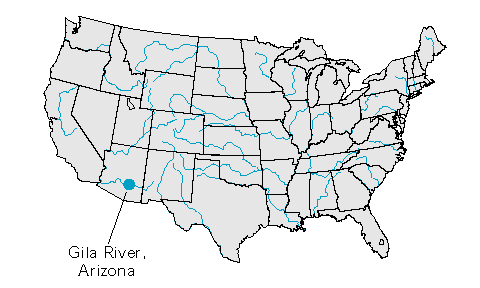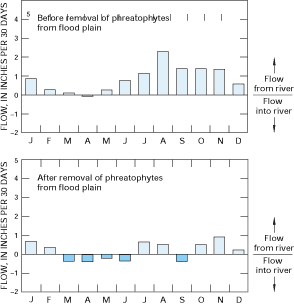R
Effects of the Removal of Flood-Plain Vegetation on the Interaction of Ground
Water and Surface Water
In low-lying areas where the
water table is close to land surface, such as in flood
plains, transpiration directly from ground water can reduce
ground-water discharge to surface water and can even cause
surface water to recharge ground water (see Figure 7). This
process has attracted particular attention in arid areas,
where transpiration by phreatophytes on flood plains of
western rivers can have a significant effect on streamflows.
To assess this effect, a study was done on transpiration by
phreatophytes along a reach of the Gila River upstream from
San Carlos Reservoir in Arizona. During the first few years
of the 10-year study, the natural hydrologic system was
monitored using observation wells, streamflow gages, and
meteorological instruments. Following this initial
monitoring period, the phreatophytes were removed from the
flood plain and the effects on streamflow were evaluated.
The average effect of vegetation removal over the entire
study reach was that the Gila River changed from a
continually losing river for most years before clearing to a
gaining stream during some months for most years following
clearing. Specifically, average monthly values of gain or
loss from the stream indicated that before clearing, the
river lost water to ground water during all months for most
years. After clearing, the river gained ground-water inflow
during March through June and during September for most
years (Figure R-1).
Figure R-1: Removal of phreatophytes from the flood plain along
a losing reach of the Gila River in Arizona resulted in the river receiving
ground-water inflow during some months of the year. (Modified from Culler, R.C.,
Hanson, R.L., Myrick, R.M., Turner, R.M., and Kipple, F.P., 1982, Evapotranspiration
before and after clearing phreatophytes, Gila River flood plain, Graham County,
Arizona: U.S. Geological Professional Paper 655-P.)
|

